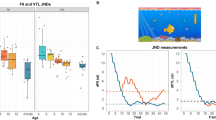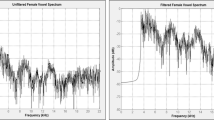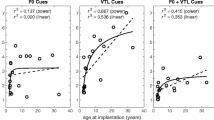Abstract
In normal hearing (NH), the perception of the gender of a speaker is strongly affected by two anatomically related vocal characteristics: the fundamental frequency (F0), related to vocal pitch, and the vocal tract length (VTL), related to the height of the speaker. Previous studies on gender categorization in cochlear implant (CI) users found that performance was variable, with few CI users performing at the level of NH listeners. Data collected with recorded speech produced by multiple talkers suggests that CI users might rely more on F0 and less on VTL than NH listeners. However, because VTL cannot be accurately estimated from recordings, it is difficult to know how VTL contributes to gender categorization. In the present study, speech was synthesized to systematically vary F0, VTL, or both. Gender categorization was measured in CI users, as well as in NH participants listening to unprocessed (only synthesized) and vocoded (and synthesized) speech. Perceptual weights for F0 and VTL were derived from the performance data. With unprocessed speech, NH listeners used both cues (normalized perceptual weight: F0 = 3.76, VTL = 5.56). With vocoded speech, NH listeners still made use of both cues but less efficiently (normalized perceptual weight: F0 = 1.68, VTL = 0.63). CI users relied almost exclusively on F0 while VTL perception was profoundly impaired (normalized perceptual weight: F0 = 6.88, VTL = 0.59). As a result, CI users’ gender categorization was abnormal compared to NH listeners. Future CI signal processing should aim to improve the transmission of both F0 cues and VTL cues, as a normal gender categorization may benefit speech understanding in competing talker situations.



Similar content being viewed by others
Notes
VTL affects the center frequency of the formants and is sometimes referred to as ‘formant dispersion’: lengthening the vocal tract by a given factor results in dividing all formant frequencies by that same factor, equivalent to an homothetic translation of the spectral envelope on a log-frequency axis (a detailed explanation can be found in Patterson et al. 2010). One of the main differences between VTL and F0, unlike for glottal pulse rate, F0, and pitch, there are no commonly defined terms to denote the acoustic and perceptual analogs of VTL. In the present study, we therefore used the term VTL to refer to the physical dimension, the apparent acoustic dimension, as well as the perceived quantity related to this anatomical property.
References
Anderson ES, Nelson DA, Kreft H, Nelson PB, Oxenham AJ (2011) Comparing spatial tuning curves, spectral ripple resolution, and speech perception in cochlear implant users. J Acoust Soc Am 130:364–375. doi:10.1121/1.3589255
Bates D, Maechler M, Bolker B, Walker S (2013) lme4: Linear mixed-effects models using Eigen and S4. http://cran.r-project.org/package=lme4. Version 1.1-6
Bosman AJ, Smoorenburg GF (1995) Intelligibility of Dutch CVC syllables and sentences for listeners with normal hearing and with three types of hearing impairment. Audiology 34:260–284
Brungart DS (2001) Informational and energetic masking effects in the perception of two simultaneous talkers. J Acoust Soc Am 109:1101–1109
Churchill TH, Kan A, Goupell MJ, Ihlefeld A, Litovsky RY (2014) Speech perception in noise with a harmonic complex excited vocoder. J Assoc Res Otolaryngol 15:265–278. doi:10.1007/s10162-013-0435-7
Clarke J., Gaudrain E., Chatterjee M., Başkent D (2014) T’ain’t the way you say it, it’s what you say—perceptual continuity and top-down restoration of speech. Hear Res, 315:80–387.
Darwin CJ, Brungart DS, Simpson BD (2003) Effects of fundamental frequency and vocal-tract length changes on attention to one of two simultaneous talkers. J Acoust Soc Am 114:2913–2922
Fant G (1970) Acoustic theory of speech production. Walter de Gruyter, The Hague
Festen JM, Plomp R (1990) Effects of fluctuating noise and interfering speech on the speech-reception threshold for impaired and normal hearing. J Acoust Soc Am 88:1725–1736
Fitch WT, Giedd J (1999) Morphology and development of the human vocal tract: a study using magnetic resonance imaging. J Acoust Soc Am 106:1511–1522
Fitzsimons M, Sheahan N, Staunton H (2001) Gender and the integration of acoustic dimensions of prosody: implications for clinical studies. Brain Lang 78:94–108
Friesen LM, Shannon RV, Başkent D, Wang X (2001) Speech recognition in noise as a function of the number of spectral channels: comparison of acoustic hearing and cochlear implants. J Acoust Soc Am 110:1150–1163
Fu QJ, Chinchilla S, Galvin JJ III (2004) The role of spectral and temporal cues in voice gender discrimination by normal-hearing listeners and cochlear implant users. J Assoc Res Otolaryngol 5:253–260
Fu QJ, Chinchilla S, Nogaki G, Galvin JJ III (2005) Voice gender identification by cochlear implant users: the role of spectral and temporal resolution. J Acoust Soc Am 118:1711–1718
Fuller CD, Free RH, Maat B, Başkent D (2012) Musical background not associated with self-perceived hearing performance or speech perception in postlingual cochlear-implant users. J Acoust Soc Am 132:1009–1016. doi:10.1121/1.4730910
Fuller CD, Galvin JJ III, Free RH, Başkent D (2014) Musician effect in cochlear implant simulated gender categorization. J Acoust Soc Am 135:EL159–EL165
Greenwood DD (1990) A cochlear frequency‐position function for several species—29 years later. J Acoust Soc Am 87:2592
Holmberg EB, Hillman RE, Perkell JS (1988) Glottal airflow and transglottal air pressure measurements for male and female speakers in soft, normal, and loud voice. J Acoust Soc Am 84:511
Jaeger TF (2008) Categorical data analysis: away from ANOVAs (transformation or not) and towards logit mixed models. J Mem Lang 59:434–446. doi:10.1016/j.jml.2007.11.007
Kawahara H, Masuda-Katsuse I, de Cheveigné A (1999) Restructuring speech representations using a pitch-adaptive time–frequency smoothing and an instantaneous-frequency-based F0 extraction: possible role of a repetitive structure in sounds. Speech Commun 27:187–207
Kovačić D, Balaban E (2009) Voice gender perception by cochlear implantees. J Acoust Soc Am 126:762–775
Kovačić D, Balaban E (2010) Hearing history influences voice gender perceptual performance in cochlear implant users. Ear Hear 31:806–814
Lammert A, Proctor M, Narayanan S (2013) Morphological variation in the adult hard palate and posterior pharyngeal wall. J Speech Lang Hear Res 56:521–530
Laneau J, Wouters J (2004) Multichannel place pitch sensitivity in cochlear implant recipients. J Assoc Res Otolaryngol 5:285–294. doi:10.1007/s10162-004-4049-y
Luo X, Fu QJ, Wu HP, Hsu CJ (2009) Concurrent-vowel and tone recognition by Mandarin-speaking cochlear implant users. Hear Res 256:75–84
Mackersie CL, Dewey J, Guthrie LA (2011) Effects of fundamental frequency and vocal-tract length cues on sentence segregation by listeners with hearing loss. J Acoust Soc Am 130:1006–1019. doi:10.1121/1.3605548
Massida Z, Marx M, Belin P et al (2013) Gender categorization in cochlear implant users. J Speech Lang Hear Res 56:1389–1401. doi:10.1044/1092-4388(2013/12-0132)
Moore BC, Carlyon RP (2005) Perception of pitch by people with cochlear hearing loss and by cochlear implant users. In: Pitch. Springer, pp 234-277
Patterson RD, Gaudrain E, Walters TC (2010) The perception of family and register in musical notes. In: Jones MR, Fay RR, Popper AN (eds) Music perception, 1st Edition. Springer, pp 13–50
Peng S-C, Lu N, Chatterjee M (2009) Effects of cooperating and conflicting cues on speech intonation recognition by cochlear implant users and normal hearing listeners. Audiol Neurotol 14:327–337. doi:10.1159/000212112
Peterson GE, Barney HL (1952) Control methods used in a study of the vowels. J Acoust Soc Am 24:175–184
Rogers CF, Healy EW, Montgomery AA (2006) Sensitivity to isolated and concurrent intensity and fundamental frequency increments by cochlear implant users under natural listening conditions. J Acoust Soc Am 119:2276–2287
Skuk VG, Schweinberger SR (2013) Influences of fundamental frequency, formant frequencies, aperiodicity and spectrum level on the perception of voice gender. J Speech Lang Hear Res. doi: 10.1044/1092-4388(2013/12-0314)
Smith DR, Patterson RD (2005) The interaction of glottal-pulse rate and vocal-tract length in judgements of speaker size, sex, and age. J Acoust Soc Am 118:3177–3186
Smith DR, Walters TC, Patterson RD (2007) Discrimination of speaker sex and size when glottal-pulse rate and vocal-tract length are controlled. J Acoust Soc Am 122:3628–3639
Stickney GS, Zeng F, Litovsky R, Assmann P (2004) Cochlear implant speech recognition with speech maskers. J Acoust Soc Am 116:1081
Van Borsel J, Janssens J, De Bodt M (2009) Breathiness as a feminine voice characteristic: a perceptual approach. J Voice 23:291–294
Wilkinson EP, Abdel-Hamid O, Galvin JJ III, Jiang H, Fu QJ (2013) Voice conversion in cochlear implantation. Laryngoscope 123(Suppl 3):S29–S43
Wilson BS, Finley CC, Lawson DT et al (1991) Better speech recognition with cochlear implants. Nature 352:236–238. doi:10.1038/352236a0
Won JH, Drennan WR, Rubinstein JT (2007) Spectral-ripple resolution correlates with speech reception in noise in cochlear implant users. J Assoc Res Otolaryngol 8:384–392. doi:10.1007/s10162-007-0085-8
Acknowledgments
We would like to thank the participants in this study. Furthermore, we would like to thank Joeri Smit and Karin van der Velde for their help with collecting the data, as well as Anita Wagner for her advice regarding statistical methods. The fourth author is supported by a NIH R01-DC004792 grant. The sixth author is supported by an otological/neurotological stipendium from the Heinsius-Houbolt Foundation. The last author is supported by a Rosalind Franklin Fellowship from the University Medical Center Groningen, University of Groningen and the VIDI grant 016.096.397 from the Netherlands Organization for Scientific Research (NWO) and the Netherlands Organization for Health Research and Development (ZonMw). The study is part of the research program of our department: Healthy Aging and Communication.
Conflict of Interest
There is no conflict of interest regarding this manuscript.
Author information
Authors and Affiliations
Corresponding author
Rights and permissions
About this article
Cite this article
Fuller, C.D., Gaudrain, E., Clarke, J.N. et al. Gender Categorization Is Abnormal in Cochlear Implant Users. JARO 15, 1037–1048 (2014). https://doi.org/10.1007/s10162-014-0483-7
Received:
Accepted:
Published:
Issue Date:
DOI: https://doi.org/10.1007/s10162-014-0483-7




